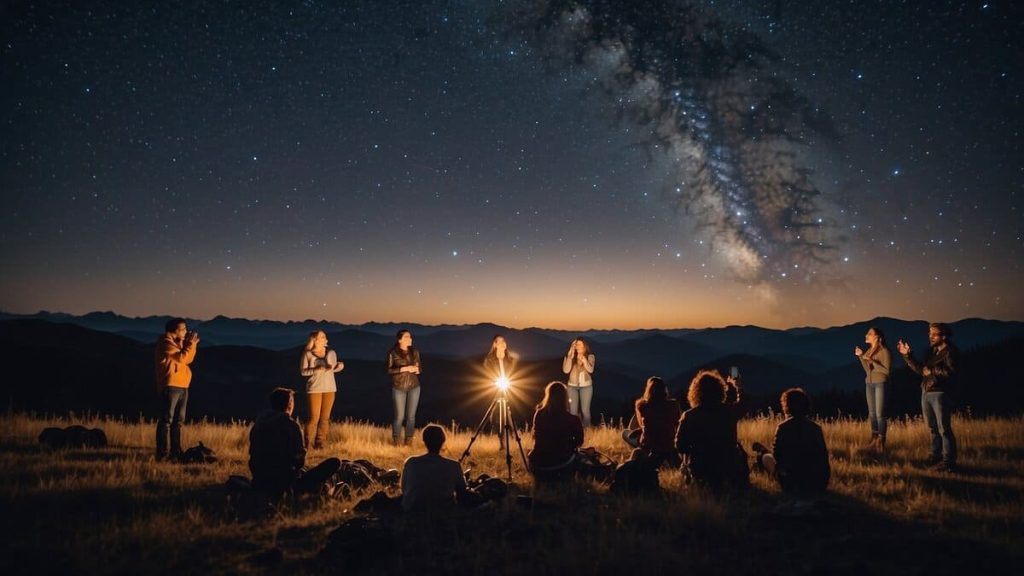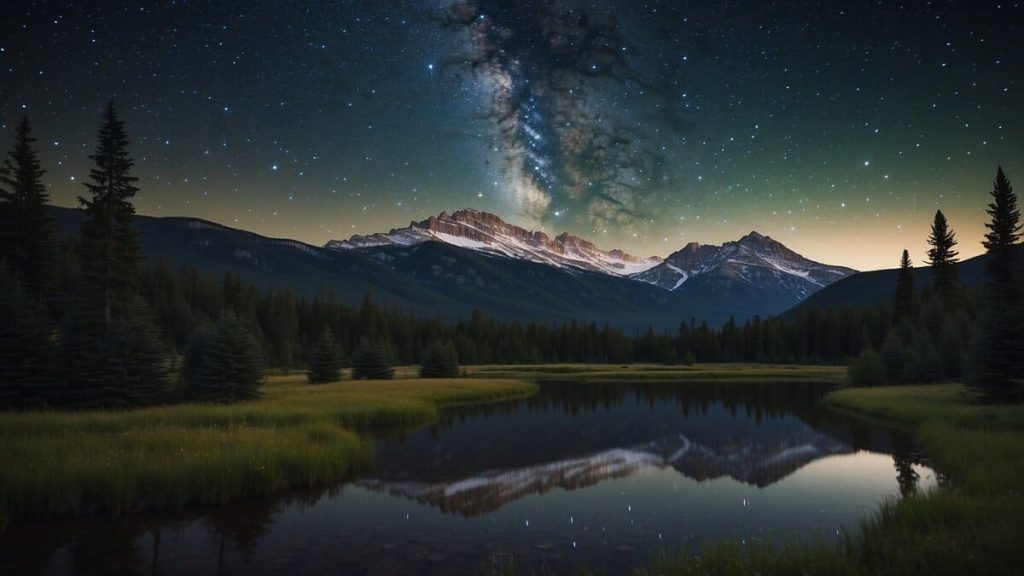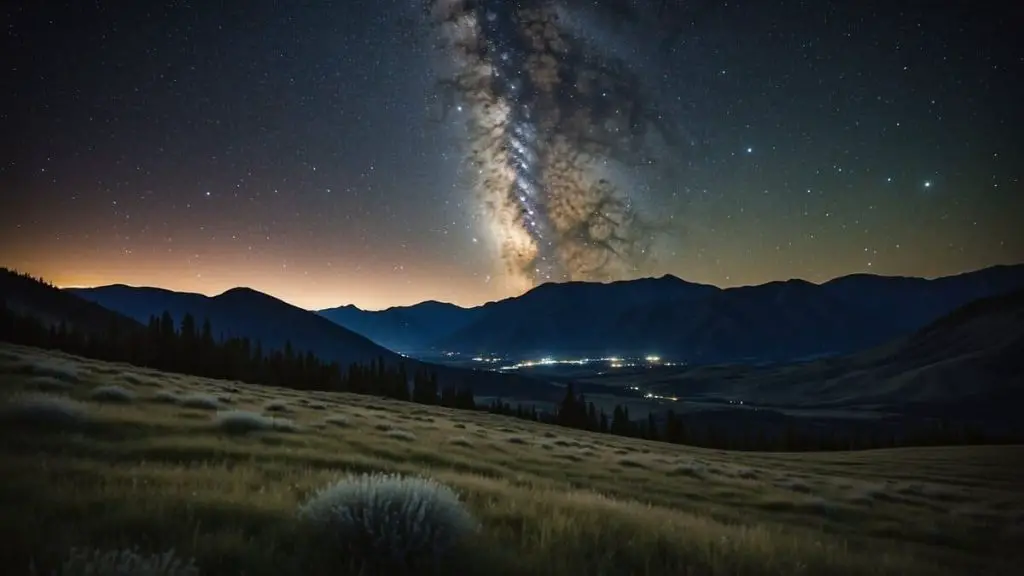Montana’s clear, dark skies are a paradise for stargazers. You can see countless stars, the Milky Way, and even the Northern Lights.
However, finding the perfect spot with minimal light pollution can be challenging. Knowing when and where to look for the best views is crucial.
In this article, I guide you through the best locations and times to experience Montana’s night sky. You’ll learn about Dark Sky Parks, moon phases, and local stargazing events, ensuring your night sky adventure is unforgettable.
Key Things to Know:
- Montana’s Dark Sky locations offer stunning stars and the Milky Way views.
- Best stargazing during a new moon; even full moon nights offer beauty.
- Dark Sky Parks and Sanctuaries preserve ideal stargazing conditions.
- Join local astronomy clubs and events for enhanced experiences.
Understanding the Montana Dark Sky Map

Montana’s skies are known for their darkness, making them an excellent spot for stargazing in the US.
Here’s what I’ve learned from my experiences to help you enjoy Montana’s night sky to the fullest:
- Dark Skies: I’ve visited several of Montana’s Dark Sky locations and found their minimal light pollution ideal for stargazing. The low light pollution makes the stars appear brighter and more numerous to the naked eye.
- The Milky Way: I vividly remember nights when the Milky Way’s dusty band stretched clearly across the sky. It’s a breathtaking view of our own galaxy.
- Find a Dark Sky area. The less light around you, the better the stars will appear.
- Give your eyes time to adjust to the darkness. This usually takes about 20 minutes.
- Look for faint objects like the Milky Way first, which are harder to spot.
FREE STARGAZING CHECKLIST
My 5-page Stargazing Checklist will enhance your astronomical observations.
Follow this free checklist to navigate the night sky with confidence, clarity, and a sense of preparedness for a rewarding stargazing experience.

- From my experience, the new moon phase offers the darkest skies, ideal for viewing dim stars and galaxies.
- Even during a full moon, you can enjoy the night sky’s beauty, though you might not see as many stars.
Northern Lights: Occasionally, you may catch the Aurora Borealis or Northern Lights in Montana. These dancing lights can add a magical glow to the night sky if conditions are right.
Remember, Montana’s star-filled night skies are a treasure. By respecting the Dark Sky places and lowering light pollution, you’re helping preserve this natural beauty for everyone.
Dark Sky Preserves and Parks

Montana offers some of the best night sky viewing in the United States. You can find these views in designated areas that protect the night from light pollution.
National Dark Sky Parks
Glacier National Park is one of Montana’s national treasures, where the stars light up the sky. Here’s what you should know:
- Glacier National Park: Recognized as an International Dark Sky Park. This park has tried to reduce light pollution so the stars shine at night. You can enjoy the view from many spots within the park.
- Dark Sky Park: This title means the park has taken special care to keep the skies dark for stargazing. Visit one and see billions of stars with your own eyes.
State Dark Sky Sanctuaries
State parks and public lands also work to preserve the dark sky.
Check out these places:
- Medicine Rocks State Park: A haven for stargazers, this state park is a Dark Sky Sanctuary. It’s a place to keep the sky dark and the stars clear.
- Dark Sky Sanctuary: These spots are on public lands and are protected for their night skies. The state works hard to keep these areas dark so you see stars, not streetlights.
Remember to respect these areas. They help us keep the stars bright for everyone. Enjoy the night sky!
Star Gazing Events and Clubs

Montana’s clear skies make it a prime spot for stargazing and astronomy events. You’ll find a way to wander in the night sky, from clubs to star parties.
Astronomy Clubs
If you want to connect with fellow star enthusiasts, joining an astronomy club is a great start. Clubs often meet for stargazing events and share tips on seeing the stars.
- Missoula Central Montana Astronomy Society – A place for those in the Missoula area to learn and share their passion for the stars.
- Big Sky Astronomy Club – Offering gatherings for stargazing and educational events near the Big Sky area.
Star Parties and Events
I’ve attended several of these gatherings, and each night under the stars has been unforgettable. Star parties and events are special nights when the skies are clear, and the stars come out to play.
- Montana Learning Center – Hosts a variety of workshops and camps that often include chances to see the stars up close through telescopes.
- Held at dark sky parks or other remote locations, these events are fantastic ways to see the night sky in all its glory.
Remember, you can join in on events with an astronomy club or visit a dark sky party to experience Montana’s breathtaking night sky.
Light Pollution Awareness and Mapping

As I’ve observed, light pollution, with its excess artificial light, drastically diminishes the visibility of stars at night. It can hide stars from view and upset natural patterns. I want to talk about how we can see where light pollution is and understand it better.
Bortle Scale: A way to measure sky darkness. It goes from 1 to 9, with 1 being the darkest sky possible.

Here’s how you can use light pollution maps:
- Find a map.
- Look for dark spots using the Bortle scale colors.
- Choose a place with a low Bortle number for the best stargazing.
Montana Dark Sky Parks & Places can help you find dark skies. The International Dark-Sky Association also works to protect our night sky. They share maps to show how bright a place is at night. The IDA Montana Chapter aims to keep Montana’s skies dark. Use their resources to better understand how to enjoy the night sky without much light pollution.
Wildlife and Natural Landscapes Under the Stars

Montana’s night skies are not just for stargazing; they’re a backdrop to some of the most stunning wildlife and landscapes. Here, you can spot some of America’s iconic animals at night and explore scenic regions.
Flora and Fauna at Night
The natural world comes alive as the stars light up the Montana sky. You might see bison grazing under the Milky Way or hear elk bugling in the distance. These sights and sounds make nighttime an unforgettable experience.
Megafauna to look for:
- Bison
- Elk
- Pronghorn antelope
The Charles M. Russell National Wildlife Refuge is a prime spot. For an amazing experience, check out the Slippery Ann Wildlife Viewing Area. In the fall, you can watch elk gather by the hundreds.
Scenic Regions and Waterways
Montana’s dark skies also mean bright stars reflect on waters like the Missouri River or Fort Peck Lake. These places are peaceful at night and filled with beauty.
Star-gazing spots by water:
- Missouri River: Stargaze as the river flows quietly.
- Fort Peck Lake: Watch stars twinkle and dance on the lake’s surface.
Remember, a night under the stars in Montana’s wild public lands is a chance to connect with nature and see the landscape in a new way.
Frequently Asked Questions

Can I still enjoy stargazing in Montana during the winter months?
Yes, stargazing in Montana during winter can be incredibly rewarding. The colder air is often clearer, providing sharper views of the stars. However, dress warmly and be prepared for potentially snowy conditions.
Are there any specific types of telescopes recommended for viewing Montana’s night sky?
For viewing Montana’s night sky, a Dobsonian telescope is highly recommended. Its simple design and large aperture make it ideal for beginners and experienced stargazers, offering clear views of galaxies and nebulae.
How can I photograph the night sky effectively in Montana’s Dark Sky locations?
To effectively photograph the night sky in Montana’s Dark Sky locations, use a DSLR camera with a wide-angle lens, a tripod, and long exposure settings. This setup captures the faintest stars and the Milky Way’s details against Montana’s dark skies.
TL;DR
- Montana offers exceptional stargazing opportunities due to its many Dark Sky locations with minimal light pollution.
- The best times for viewing the night sky are during a new moon or at designated Dark Sky Parks and Sanctuaries.
- Local astronomy clubs and star parties provide community and educational experiences for beginners and seasoned stargazers.
- Light pollution maps and the Bortle Scale can help identify the best stargazing spots in Montana.
- Montana’s unique wildlife and landscapes enhance the night sky viewing experience, especially in areas like Glacier National Park and Medicine Rocks State Park.
Your curiosity and insights make our stargazing community richer! If you have questions about Montana’s night skies or want to share your experiences, I’m here to engage and learn with you.
Let’s keep the conversation going – leave your thoughts and questions in the comments below.




